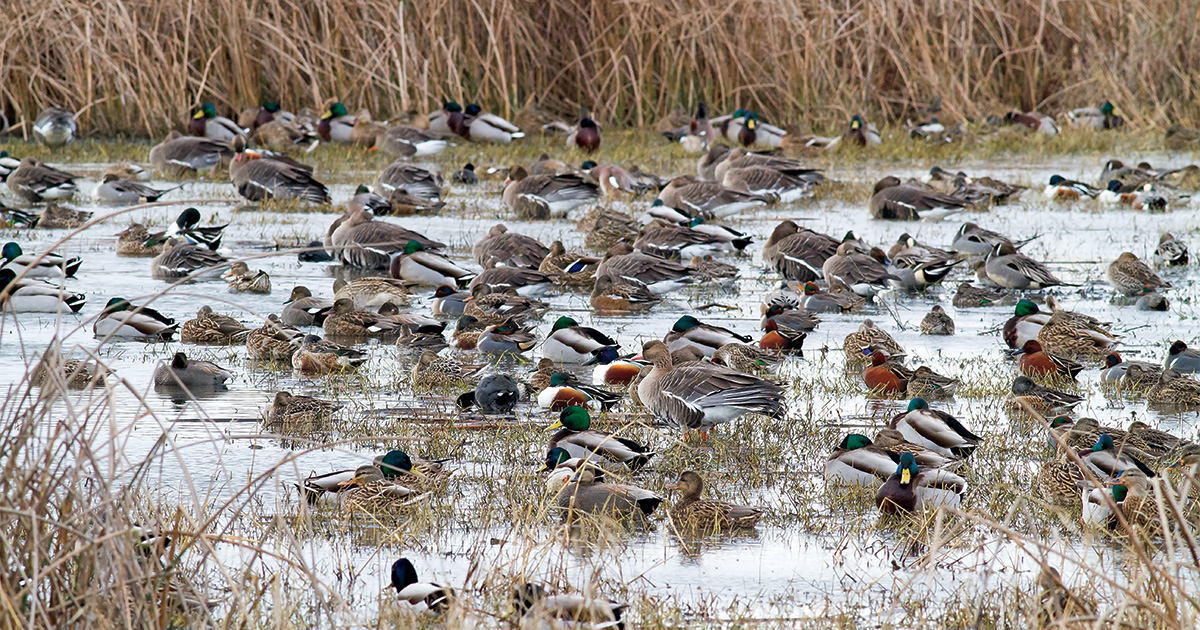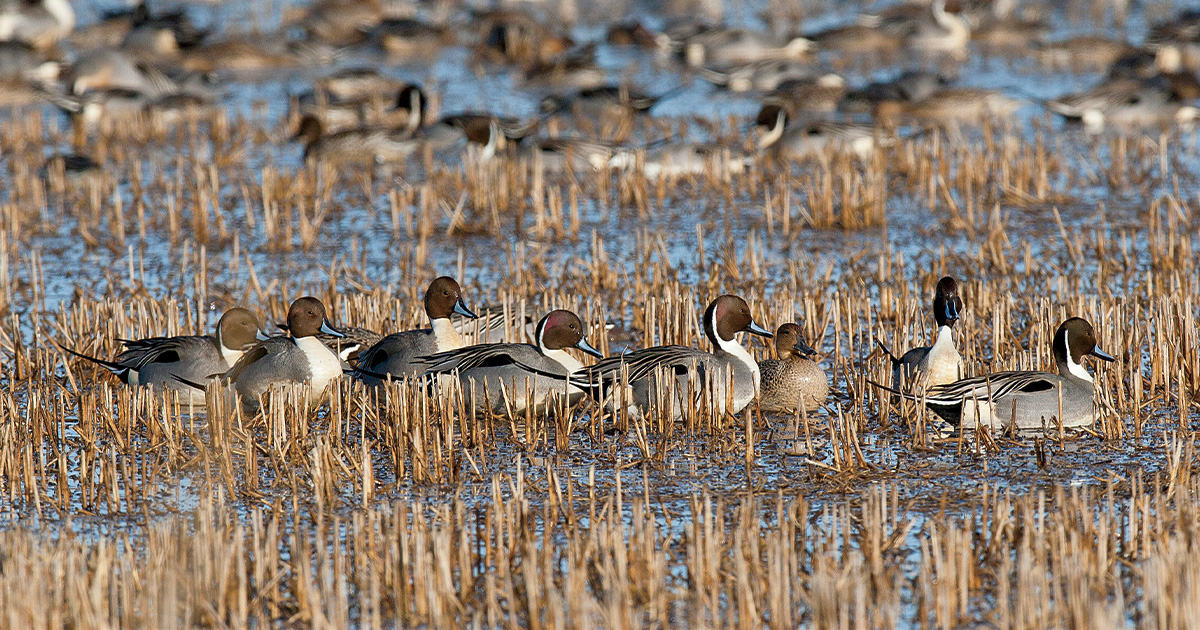Understanding Waterfowl: The Two Sides of Drought
Prolonged periods of dry weather can have both positive and negative impacts on waterfowl and their habitats
Prolonged periods of dry weather can have both positive and negative impacts on waterfowl and their habitats
From the Ducks Unlimited magazine Archives
By Mike Brasher, Ph.D.; Kaylan Kemink ; and Dale James, Ph.D.

Although drought temporarily reduces the amount of habitat available for waterfowl, such conditions also help maintain the productivity of wetland systems.
The prospects of a severe drought can strike fear into the hearts of duck hunters, and for good reason. Drought usually results in fewer wetlands to support breeding waterfowl, and thus lower duck production, or less habitat during the migration and wintering periods, and therefore fewer places to hunt. But it might come as a surprise that not all aspects of drought are bad for waterfowl. Let's explore the many ways in which periodic drought affects waterfowl across their annual cycle.
We start our journey in the Prairie Pothole Region (PPR) of the United States and Canada. Dotting this landscape are hundreds of thousands of shallow wetlands, known as prairie potholes, which in combination with adjacent nesting habitats, annually support 50 to 80 percent of North America's breeding ducks. Prairie potholes are unique among freshwater wetlands because of the variability of their water levels from year to year. The smallest and shallowest of these wetlands are typically the most dynamic and productive. These seasonally flooded basins fill with snowmelt in early spring, explode with invertebrate production as the weather warms, and then dry out during summer. Deeper potholes remain flooded into summer, providing valuable brood-rearing habitat for waterfowl. In contrast, permanent wetlands often support fish populations and produce fewer invertebrates, limiting their waterfowl habitat value. During abnormally wet periods that last several years, prairie potholes can begin to function like these less-productive permanent wetlands. When this occurs, a return of drier conditions, often in the form of drought, is needed to stimulate the decomposition of organic matter and recycling of nutrients that have accumulated in the low-oxygen soils of perennially flooded wetlands.
Despite the important role that drought plays in maintaining the productivity of prairie potholes, these conditions do temporarily reduce the availability of breeding habitat for waterfowl. Decades of survey data clearly demonstrate that breeding duck numbers are closely tied to wetland density on the prairies. Over the past four decades, roughly 30 percent of the breeding populations of mallards, northern pintails, northern shovelers, blue-winged teal, and gadwalls settled in the U.S. portion of the PPR during years when this region was relatively wet. During dry years, the proportion of these populations that settled in the U.S. PPR fell to roughly 15 percent. Fortunately, it's rare for the entire PPR to experience drought at the same time, and when portions of the region are dry, breeding ducks redistribute to areas with more favorable wetland habitats.
While dry conditions may cause some ducks to overfly the prairies to the Boreal Forest, where wetland habitats are more stable, the majority of the birds continue to settle on the prairies. For example, during years when the U.S. portion of the region was dry, the PPR as a whole still supported 60 percent of the breeding populations of the five previously mentioned dabbling duck species. This illustrates the remarkable ability of the PPR to support breeding waterfowl, even when significant portions of the region are dry, and emphasizes the importance of broadly conserving prairie wetlands and adjacent uplands to offset the impacts of variable precipitation.

Beyond the breeding grounds, waterfowl depend on a great diversity of wetlands, ranging from permanent lakes and estuarine bays that support abundant divers and sea ducks to seasonal and temporary wetlands that provide crucial foraging habitat for dabblers. Like prairie potholes, some of these wetlands must go dry periodically to maintain their productivity. Typical climate and precipitation patterns on most migration and wintering areas naturally result in flooding during winter and spring, followed by drier weather during the summer, which rejuvenates wetland productivity. In fact, many wetland management practices for migrating and wintering waterfowl, such as moist-soil management, are designed to mimic natural wet and dry cycles.
However, water shortages on migration and wintering areas caused by prolonged periods of severe drought are always detrimental to waterfowl. First, reduced irrigation supplies during the growing season can adversely affect both managed wetlands and agricultural crops (especially rice), which provide vital food resources and habitat for waterfowl. Second, drought decreases the availability of surface water for managed flooding of impounded wetlands as ducks and geese begin their southward migration. Third, drought reduces the frequency and extent of natural wetland inundation from precipitation, overbank streamflow, and runoff from spring snowmelt.
Unfortunately, all these adverse effects were observed recently along the Texas Gulf Coast and in California's Central Valley (see below). Although recent wet weather has provided much-needed drought relief in these regions, continued human population growth, increased demand for municipal and industrial water supplies, and the possibility of more severe and frequent droughts remain serious threats. Waterfowl are well adapted to naturally occurring drought conditions, but habitat loss and competition for limited water supplies will likely result in more severe impacts on waterfowl populations in the future.
The size and health of waterfowl populations are a direct reflection of the abundance and productivity of the wetland habitats on which the birds depend. For this reason, Ducks Unlimited and its partners are dedicated to conserving abundant and intact prairie potholes and other wetlands on the breeding grounds, while simultaneously pursuing policies and programs that will ensure reliable water supplies for wetland management and a sustainable rice industry on key migration and wintering areas. These continental conservation efforts are more important now than ever to ensure that North America's waterfowl will continue to have the habitats they need today and in the future.

Ensuring reliable water supplies for rice agriculture is a top priority for Ducks Unlimited in California and along the Texas Gulf Coast.
Learning from Drought in Texas and California: Since 2010, two of DU's highest-priority conservation areas—the Central Valley of California and the Texas Gulf Coast—have battled record droughts spanning many years. Wetland systems in the Central Valley are intensively managed for waterfowl food production, and together with post-harvest flooded rice fields they support 5 million to 7 million waterfowl annually. From 2011 to 2016, California experienced one of the most severe droughts in its history. Managed wetlands in this region rely heavily on surface water from state and federal water projects, but reservoir levels during the drought were at less than 50 percent of capacity. At the peak of the drought, in 2014, waterfowl managers braced for water restrictions that would have reduced managed wetland habitat by 25 percent and winter-flooded rice by 75 percent. Thankfully, timely rainfall arrived during the winter, averting what could have been severe waterfowl habitat shortages.
On the Texas Gulf Coast, where rice fields are vital to more than 5 million ducks and geese, the acreage of planted rice has declined by over 300,000 acres since the 1970s. This decline has been driven in part by increased competition for water supplies, and the recent drought of 2010-2014 demonstrated the seriousness of this threat. Prompted by declining water levels in upstream lakes, regional water authorities curtailed releases of irrigation water to downstream rice farmers for four consecutive growing seasons, causing an immediate 52,000-acre reduction in planted rice. Lake levels eventually recovered, and in 2016 Texas farmers planted the largest rice acreage since 2005. While Texas and California have both recovered from their recent droughts, these events serve as a stark reminder of the importance of DU's work to ensure reliable water supplies for wetlands and agriculture on these vital landscapes.
Ducks Unlimited uses cookies to enhance your browsing experience, optimize site functionality, analyze traffic, and deliver personalized advertising through third parties. By continuing to use this site, you agree to our use of cookies. View Privacy Policy